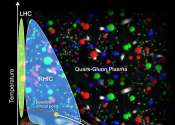Super strong magnetic fields leave imprint on nuclear matter
A new analysis by the STAR collaboration at the Relativistic Heavy Ion Collider (RHIC), a particle collider at the U.S. Department of Energy's (DOE) Brookhaven National Laboratory, provides the first direct evidence of the ...









